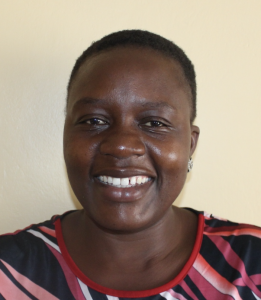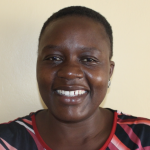Silungai B is a rich area bursting with nature. As you approach this community you see the green vegetation of maize and trees all over. The area is also a bit rocky, especially as you approach the spring. On the lower side of the community is a river that marks the boundary of the village. The road leading to the spring is made of murram, or packed clay and gravel, off the busy Kakamega-Eldoret tarmac road.
In Silungai B, most people are large-scale farmers with the dominant crop being maize. During our visit, the maize was ready and drying up in the farms before harvesting. Others are sugarcane farmers. Most of the youth are boda boda, or motorbike taxi, riders at the shopping center of Silungai.
This community is unique as it borders the famous Chimoi Market that has been known for a long time as a center of long-distance truck drivers ferrying goods from Mombasa to Uganda and Tanzania. As you approach the center, you are met by a long trail of trucks waiting to cross the border in either direction. During the pandemic, the trail has been long and slow and many trucks were parked alongside the busy Kakamega Eldoret tarmac road as their drivers alight for snacks and other necessities.
The lack of safe water in this area has long had a negative impact on the health of the 420 people who depend on Tali Saya Spring for their daily water needs. Community members report frequent episodes of stomachaches and diarrhea after drinking the spring water, with children under 5 being the most common visitors to the Silungai Dispensary due to water-related illnesses.
Because it is completely open, the spring is vulnerable to contamination from surface run-off, which brings with it farm chemicals and animal waste, among other toxins. The money families spend on medical treatment could be saved or better spent on other critical needs, they say, but they keep having to pay for medicine and hospital visits instead. When they are sick, adults miss out on work and kids stay home from school, hurting both group's potential for success.
"My name is Ruth Timothy. I have been married in this community for the last 15 years. Our only water source is this unprotected spring. This spring never dries up during the dry season. But as a result of it being open to contamination, we have constantly suffered from waterborne disease outbreaks. These diseases have constantly drained my family of the little resources we have in treating the diseases. We appeal for your help in protecting this spring so that we can live better and healthy lives," 48-year-old Ruth said.
Poor accessibility has also been a challenge at Tali Saya Spring. Whenever it rains, the area leading up to the spring becomes slick with mud. Falls, spilled water, and injuries are common consequences of trying to leave the spring. Many children fear going to the spring because of its bushy surroundings, where snakes and other potentially dangerous animals can easily hide.
Community members tried to improvise a discharge pipe at the spring using a piece of sheet metal stuck directly into the ground, but the metal inevitably misses some of the water as it runs around and under the sheet. This adds to the lines and crowds at the spring, which are especially unwanted during the pandemic when people are trying to avoid groups and limit their time in public.
The frequent rains often wash the metal away. And to reach the metal sheet in any weather, community members must try to balance on the rocks they placed just below it, trying to avoid standing in the pool of water directly beneath the spring's output. It's a slippery and precarious position to be in, let alone to get out of while carrying 1 or more full containers of water.
"I dread each day going to the spring, especially when it has rained. One time I slipped and fell with water on my head, spraining my ankle. We are glad that you have come to help," shared hopeful young teenager Rabecah.
What We Can Do:
Spring Protection
Protecting the spring will help provide access to cleaner and safer water and reduce the time people have to spend to fetch it. Construction will keep surface runoff and other contaminants out of the water. With the community’s high involvement in the process, there should be a good sense of responsibility and ownership for the new clean water source.
Fetching water is a task predominantly carried out by women and young girls. Protecting the spring and offering training and support will, therefore, help empower the female members of the community by freeing up more of their time and energy to engage and invest in income-generating activities and their education.
Training on Health, Hygiene, COVID-19, and More
To hold trainings during the pandemic, we work closely with both community leaders and the local government to approve small groups to attend training. We ask community leaders to invite a select yet representative group of people to attend training who will then act as ambassadors to the rest of the community to share what they learn. We also communicate our expectations of physical distancing and wearing masks for all who choose to attend.
The training will focus on improved hygiene, health, and sanitation habits in this community. We will also have a dedicated session on COVID-19 symptoms, transmission routes, and prevention best practices.
With the community’s input, we will identify key leverage points where they can alter their practices at the personal, household, and community levels to affect change. This training will help to ensure participants have the knowledge they need about healthy practices and their importance to make the most of their water point as soon as water is flowing.
Our team of facilitators will use a variety of methods to train community members. Some of these methods include participatory hygiene and sanitation transformation, asset-based community development, group discussions, handouts, and demonstrations at the spring.
One of the most important issues we plan to cover is the handling, storage, and treatment of water. Having a clean water source will be extremely helpful, but it is useless if water gets contaminated by the time it is consumed. We and the community strongly believe that all of these components will work together to improve living standards here, which will help to unlock the potential for these community members to live better, healthier lives.
We will then conduct a small series of follow-up trainings before transitioning to our regularly scheduled support visits throughout the year.
Training will result in the formation of a water user committee, elected by their peers, that will oversee the operations and maintenance of the spring. The committee will enforce proper behavior around the spring and delegate tasks that will help preserve the site, such as building a fence and digging proper drainage channels. The fence will keep out destructive animals and unwanted waste, and the drainage will keep the area’s mosquito population at a minimum.
Sanitation Platforms
At the end of the training, participants will select 5 families that should benefit from new concrete latrine floors called sanitation platforms. Training will inform the community and selected families on what they need to contribute to make this project a success. They must mobilize locally available materials, including bricks, clean sand, and gravel. The 5 families chosen for sanitation platforms must prepare by sinking a pit for the sanitation platforms to be placed over.
All community members must work together to make sure that accommodations and food are always provided for the work teams. The families will then be asked to complete their latrines by constructing a superstructure over their platforms. These 5 sanitation platforms will then serve as examples for the rest of the community to replicate.

 Protected Spring
Protected Spring
 Rehabilitation Project
Rehabilitation Project
















































